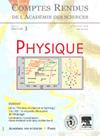用日冕仪成像系外行星
IF 1.2
4区 物理与天体物理
Q3 ASTRONOMY & ASTROPHYSICS
引用次数: 7
摘要
系外行星科学是当今天文学的一个非常活跃的领域,仍然存在诸如行星系统如何形成和演化(发生,过程),为什么观察到如此多样化的系外行星(质量,半径,轨道参数,温度,组成)以及行星,星周盘和它们的宿主恒星之间的相互作用是什么等问题。有几种互补的方法用于探测系外行星。其中,成像旨在直接探测系外行星和星周盘反射、散射或发射的光。这允许它们的光谱和偏振表征。这样的成像仍然具有挑战性,因为大的光度比(1e4-1e10美元)和小的角距(角秒的几分之一)之间的恒星和它的环境。在过去的二十年里,包括日冕学在内的许多技术已经被开发出来,使系外行星成像成为现实。这篇综述给出了一个子系统的广泛概述,构成一个日冕仪器成像系外行星系统。它特别适用于该领域的非专业人士或新手。我们解释了日冕学的原理,并提出了一种形式主义来理解它们的行为。我们讨论了波前像差对日冕仪性能的影响,以及它们如何在科学图像中引起恒星斑点。最后,我们提出了用于天空最小化或这些斑的后验校准的仪器和信号处理技术,以提高日冕仪的性能。本文章由计算机程序翻译,如有差异,请以英文原文为准。
Imaging exoplanets with coronagraphic instruments
Exoplanetary science is a very active field of astronomy nowadays, with questions still opened such as how planetary systems form and evolve (occurrence, process), why such a diversity of exoplanets is observed (mass, radius, orbital parameters, temperature, composition), and what are the interactions between planets, circumstellar disk and their host star. Several complementary methods are used for the detection of exoplanets. Among these, imaging aims at the direct detection of the light reflected, scattered or emitted by exoplanets and circumstellar disks. This allows their spectral and polarimetric characterization. Such imaging remains challenging because of the large luminosity ratio (1e4-1e10$) and the small angular separation (fraction of an arcsecond) between the star and its environment. Over the past two decades, numerous techniques, including coronagraphy, have been developed to make exoplanet imaging a reality. This review gives a broad overview of the subsystems that make up a coronagraphic instrument for imaging exoplanetary systems. It is especially intended for non-specialists or newcomers in the field. We explain the principle of coronagraphy and propose a formalism to understand their behavior. We discuss the impact of wavefront aberrations on the performance of coronagraphs and how they induce stellar speckles in the scientific image. Finally, we present instrumental and signal processing techniques used for on-sky minimization or a posteriori calibration of these speckles in order to improve the performance of coronagraphs.
求助全文
通过发布文献求助,成功后即可免费获取论文全文。
去求助
来源期刊

Comptes Rendus Physique
物理-天文与天体物理
CiteScore
2.80
自引率
0.00%
发文量
13
审稿时长
17.2 weeks
期刊介绍:
The Comptes Rendus - Physique are an open acess and peer-reviewed electronic scientific journal publishing original research article. It is one of seven journals published by the Académie des sciences.
Its objective is to enable researchers to quickly share their work with the international scientific community.
The Comptes Rendus - Physique also publish journal articles, thematic issues and articles on the history of the Académie des sciences and its current scientific activity.
From 2020 onwards, the journal''s policy is based on a diamond open access model: no fees are charged to authors to publish or to readers to access articles. Thus, articles are accessible immediately, free of charge and permanently after publication.
The Comptes Rendus - Physique (8 issues per year) cover all fields of physics and astrophysics and propose dossiers. Thanks to this formula, readers of physics and astrophysics will find, in each issue, the presentation of a subject in particularly rapid development. The authors are chosen from among the most active researchers in the field and each file is coordinated by a guest editor, ensuring that the most recent and significant results are taken into account. In order to preserve the historical purpose of the Comptes Rendus, these issues also leave room for the usual notes and clarifications. The articles are written mainly in English.
 求助内容:
求助内容: 应助结果提醒方式:
应助结果提醒方式:


